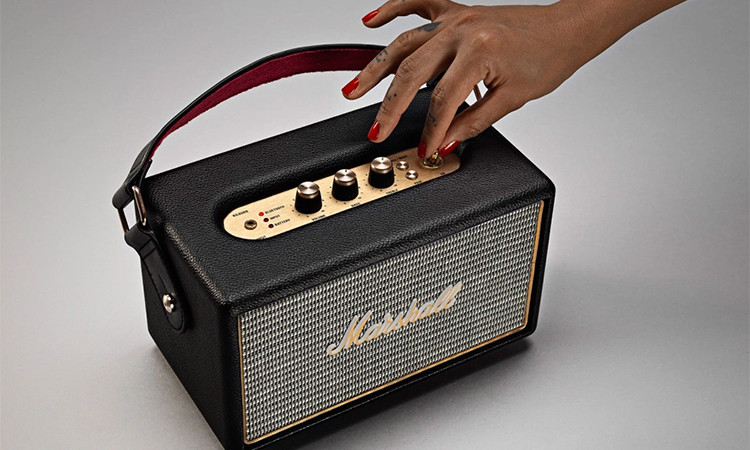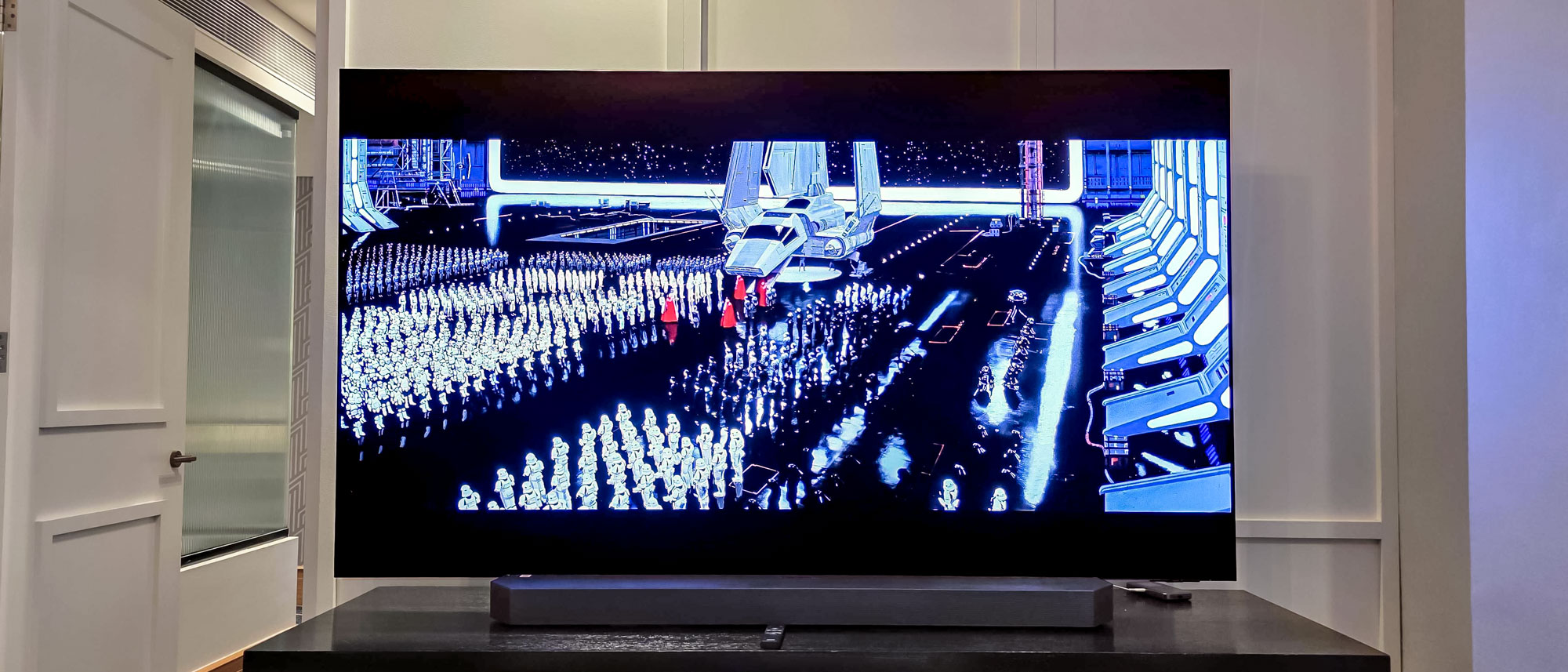Tom's Guide Verdict
With excellent fidelity and plenty of power, the portable Marshall Kilburn fills any space with great sound.
Pros
- +
Rich bass and sharp treble
- +
Big sound in a relatively small package
- +
Good battery life and replaceable battery
Cons
- -
Heavy and awkward to carry
Why you can trust Tom's Guide
Many Bluetooth speakers are sleek and modern; few are straight-up bad ass. Marshall Headphones' Kilburn Bluetooth speaker adopts the design style of Marshall's iconic guitar amplifiers, and makes the package portable with a rechargeable battery. The $299 speaker is a standout for more than just looks, though: It produces some of the best sound you'll find from any portable speaker.
Design
Wrapped in black or cream tolex — the vinyl covering found on the exterior of Marshall amps — and with a mesh grill over the drivers, the Kilburn looks like a miniature head unit for a Marshall stack guitar amplifier.
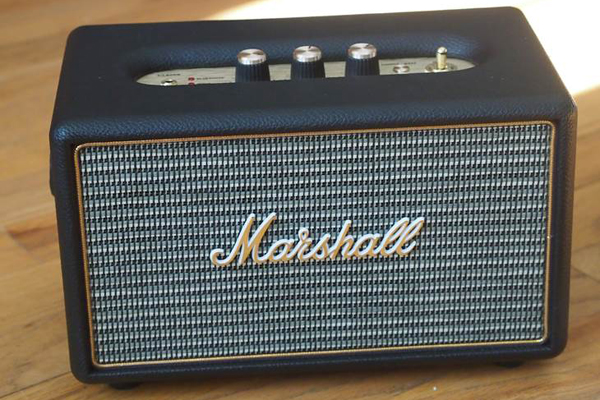
On the top, Marshall sticks with the retro theme by incorporating three control knobs: volume (sadly, it doesn't go to 11), bass and treble. Turning a knob to adjust the bass and treble makes it easy to tweak the sound to your liking. The power toggle is an actual on/off switch, and there's something satisfying about flicking it as opposed to pushing a little button. There's also a 3.5mm auxiliary input on the top so you can connect wired devices.
Indicator lights for Bluetooth connectivity, input and battery sit between the auxiliary input and volume knob. You switch the input with the Source button, which also wakes the speaker when it's in power-saving mode.

At 9.5 x 5.5 x 5.5 inches, the speaker is on the large side for a portable, and, weighing in at 6.6 pounds, you won't want to go hiking with it. Compared with the UE Megaboom, which weighs a little less than 2 pounds, the Kilburn is like a box of bricks with a leather strap. Still, having the option to use it away from a wall plug — unlike the Amazon Echo, for example — is a big bonus.
Inside, the Kilburn features two 0.75-inch tweeters and a 4-inch woofer, which spread sound more widely than you'd expect. The Kilburn's sound rivals Bluetooth speakers that are even larger, like the 16.6 x 6.1 x 4.2 Wren V5BT.
Marshall left out some features that other premium Bluetooth speakers offer, like a speakerphone and water resistance, and there's no app for controlling it. The Kilburn focuses on the music, like any hard-core rocker would.
MORE: Our Favorite Soundbars for Small and Big TVs
Setup
To pair the Kilburn with your phone or tablet, simply press the Pairing button on the top and look for "Kilburn" in your Bluetooth settings menu. This worked in a snap for both iOS and Android devices.
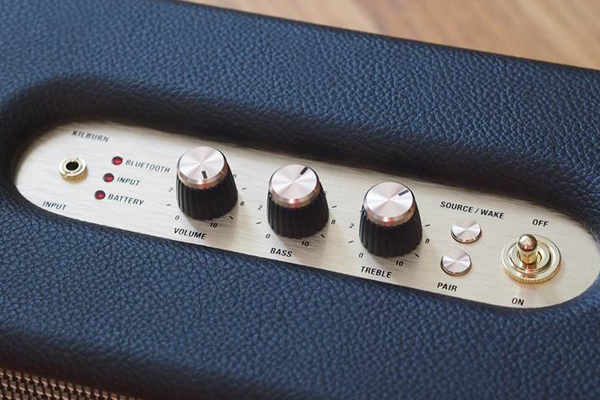
The Kilburn advertises a wireless range of about 30 feet — average for a Bluetooth speaker — and the signal stayed strong at that distance.
Once you've connected, you can adjust the bass and treble through the knobs on the top of the speaker. This is a nice touch that isn't available on many Bluetooth speakers; some, like the UE Megaboom, offer an EQ through its app, but having the knobs accessible on the speaker made me more likely to make minor adjustments based on volume and setting.
Performance
Inch-for-inch, you’ll be hard-pressed to find a speaker this small that produces bigger —or better — sound. The Kilburn easily fills a large room, or a small house. The Kilburn has overall warmer sound than the UE Megaboom, with more resonant bass and fuller vocals. Of all the Bluetooth speakers I’ve tested, only the Wren V5BT produced better overall sound, due mainly to its better midrange.

The Kilburn's rich bass and sharp treble handles most types of music well. The thumping bass drum on Florence + The Machine's "What Kind of Man" resonated deeply, and the singer's vocals sounded full. The horns on Mark Ronson's "Uptown Funk" sounded bright and crisp, while Led Zeppelin's "Custard Pie" was big and bombastic — as it is supposed to be.
The Kilburn's balance of bass and treble was especially evident at lower volumes. Many speakers shine when you turn them up, but the bass can sound weak when you turn them down. The Kilburn maintained a good balance at all levels, and when I wanted more bass, I just turned up the knob.
Marshall's speaker handled challenging recordings better than most Bluetooth speakers, too. It reproduced the ultra-distorted guitar and throbbing bass on St. Vincent's "Bad Believer" without getting muddy. Acoustic music posed no problem, either; Lindsey Buckingham’s guitar finger-picking sounded sharp and clear on Fleetwood Mac's "Never Going Back Again."
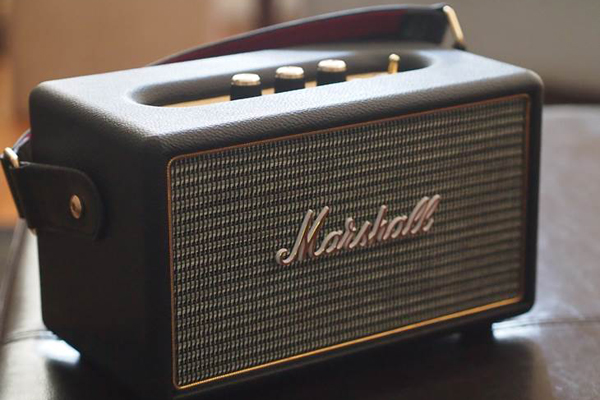
Staying true to its namesake, the Marshall gets plenty loud. The speaker maxed out at 94 decibels, and I didn't hear distortion until over 90 dBs. With that kind of power, combined with how widely the speaker spreads sound, I had no problem hearing throughout the 1,200-square-foot space I was in.
MORE: Our Favorite Outdoor (Waterproof) Speakers
Battery Life
Marshall says you can play the Kilburn for 20 hours on a full charge at 50 percent volume. I listened for more than 10 hours without issue, but I have no idea how much battery power is really left. The battery indicator blinks when it gets to 20 percent or less, but until then you'll have to guess.

The Kilburn requires a power cord connected to a wall plug to charge; it doesn't use a micro USB cable like many portables. But it does feature a replaceable battery — the first time I've seen that in a portable speaker. That means the Kilburn could be the last portable you need to buy.
Bottom Line
The Marshall Kilburn harks back to the heyday of rock 'n' roll in looks and sound: It's a portable speaker that focuses on the essentials and delivers powerful audio. While competition is tough in this price range, no other portable Bluetooth speaker can fill large spaces with such good sound quality. UE's $300 Megaboom has ruggedness but can't match the Kilburn's fidelity; Wren's $250 V5BT outperforms the Marshall's midrange but isn't portable. If you're looking for a premium Bluetooth speaker and you're into its retro aesthetics, the Kilburn really rocks.

Michael Gowan is a freelance technology journalist covering soundbars, TVs, and wireless speakers of all kinds of shapes and sizes for Tom’s Guide. He has written hundreds of product reviews, focusing on sound quality and value to help shoppers make informed buying decisions. Micheal has written about music and consumer technology for more than 25 years. His work has appeared in publications including CNN, Wired, Men’s Journal, PC World and Macworld. When Michael’s not reviewing speakers, he’s probably listening to one anyway.
